Security Landscape Outline Basic concepts from the Common
advertisement
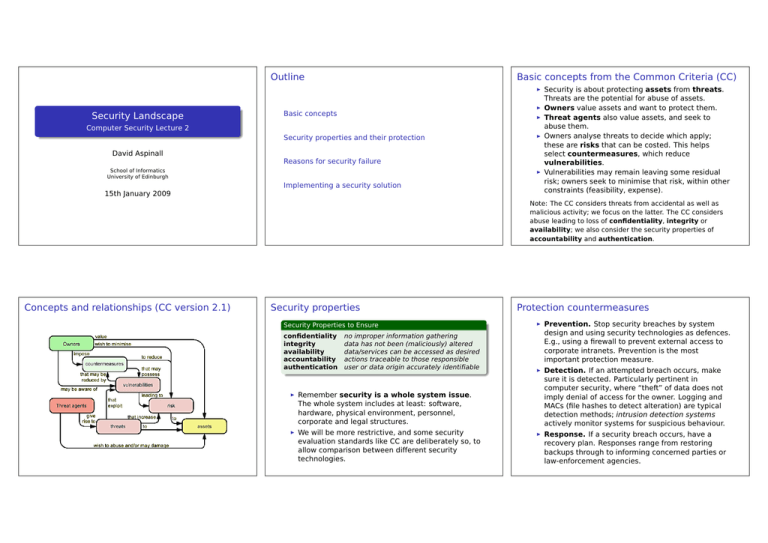
Outline Basic concepts from the Common Criteria (CC) É Security Landscape É Basic concepts É Computer Security Lecture 2 Security properties and their protection David Aspinall Reasons for security failure School of Informatics University of Edinburgh 15th January 2009 É É Implementing a security solution Security is about protecting assets from threats. Threats are the potential for abuse of assets. Owners value assets and want to protect them. Threat agents also value assets, and seek to abuse them. Owners analyse threats to decide which apply; these are risks that can be costed. This helps select countermeasures, which reduce vulnerabilities. Vulnerabilities may remain leaving some residual risk; owners seek to minimise that risk, within other constraints (feasibility, expense). Note: The CC considers threats from accidental as well as malicious activity; we focus on the latter. The CC considers abuse leading to loss of confidentiality, integrity or availability; we also consider the security properties of accountability and authentication. Concepts and relationships (CC version 2.1) Security properties Protection countermeasures Security Properties to Ensure É confidentiality integrity availability accountability authentication Prevention. Stop security breaches by system design and using security technologies as defences. E.g., using a firewall to prevent external access to corporate intranets. Prevention is the most important protection measure. É Detection. If an attempted breach occurs, make sure it is detected. Particularly pertinent in computer security, where “theft” of data does not imply denial of access for the owner. Logging and MACs (file hashes to detect alteration) are typical detection methods; intrusion detection systems actively monitor systems for suspicious behaviour. É Response. If a security breach occurs, have a recovery plan. Responses range from restoring backups through to informing concerned parties or law-enforcement agencies. no improper information gathering data has not been (maliciously) altered data/services can be accessed as desired actions traceable to those responsible user or data origin accurately identifiable É Remember security is a whole system issue. The whole system includes at least: software, hardware, physical environment, personnel, corporate and legal structures. É We will be more restrictive, and some security evaluation standards like CC are deliberately so, to allow comparison between different security technologies. Confidentiality, privacy and secrecy Information is not learned by unauthorized principals É É É É Confidentiality is characterised as preventing the unauthorized reading of data, when considering access control systems. More generally and subtly, it implies unauthorized learning of information. Confidentiality presumes a notion of authorized party, or more generally, a security (access) policy saying who or what can access our data. The security policy is used for access control. Usage: privacy refers to confidentiality for individuals; secrecy to confidentiality for organizations. Privacy is sometimes used to mean anonymity, keeping one’s identity private. Example violations: your medical records are obtained by a potential employer without your permission; a competitor steals Cadwaladers’ secret ice-cream formula. Accountability Actions are recorded and can be traced to the party responsible É If prevention methods and access controls fail, we may fall back to detection: keeping a secure audit trail is important so that actions affecting security can be traced back to the responsible party. É A stronger form of accountability is non-repudiation, when a party cannot later deny some action. É É Creating an audit trail with machine logs is tricky: if a system is compromised, logs may also be tampered with. Ways around this: send log messages to an append-only file, a separate server, or even a physically isolated printer. Example violation: an audit trail is tampered with, lost, or cannot establish where a security breach occurred. Integrity Data has not been maliciously altered É É É Integrity has more general meanings elsewhere, but in computer security we are concerned with preventing the possibly malicious alteration of data, by someone who is not authorized to do so. Integrity in this sense can be characterised as the unauthorized writing of data. Again, this presumes a policy saying who or what is allowed to alter the data. Example violation: an on-line payment system alters an electronic cheque to read £10000 instead of £100.00 Authentication Data or services available only to authorized identities É É É É Authentication is verification of identity of a person or system. Authentication is a prerequisite for allowing access to some people but denying access to others, using an access control system. An alternative is to use an previously obtained credential or permission. Authentication methods are often characterised as: something you have e.g., an entrycard something you know e.g., a password or secret key something you are e.g., a signature, biometric. Also, where you are may be implicitly or explicitly checked. Several methods may be combined. Example violations: using cryptanalysis to break crypto and learn a secret key; purporting to be somebody else (identity theft) using stolen information. Availability Data or services are accessible as expected É É É É Threats to availability cover many kinds of external environmental events (e.g., fire, pulling the server plug) as well as accidental or malicious attacks in software (e.g., infection with a debilitating virus). Computer security focuses on the second kind of threat, rather than considering general forms of fault-tolerance or dependability assurance. Ensuring availability means preventing denial of service (DoS) attacks, insofar as this is possible. It’s possible to fix attacks on faulty protocols, but attacks exhausting available resources are harder, since it can be tricky to distinguish between an attack and a legitimate use of the service. Example violations: the deadly distributed DoS (DDoS) attacks against on-line services; interfering with IP routing. Protecting authentication Protecting authentication amounts to getting it right. Spoofing authentication opens the door to breaking other security properties, so it is a focal point. É Example issues: É É É É Time of check to time of use (TOCTOU) Failures: logging and lock-out Unilateral vs mutual There are serious drawbacks with passwords: É É É É Verify knowledge of a secret, not identity. May be cracked or stolen. A trade-off: memorability/size versus strength Single sign-on appealing but delegates trust: “all eggs in one basket”. Why does security fail? Opposing forces: complexity Opposing forces: attackers É É É É É É É Opposing forces act against system security: É É É É É É É the complexity of the system, and inevitable faults; wide-ranging and unpredictable human factors; the cunning and expertise and of attackers. Engineering and management aspects impact: Complexity is one of the worst enemies of security É É poor security design from the outset; standard off-the-shelf but insecure systems; changes in environment; bad feature interaction; a failure to invest in providing security; other economic perverse incentives. É É É É É É sloppy procedure: e.g., choosing weak passwords, turning off or skipping security checks, ignoring warnings; social engineering attacks: giving information inadvertently, accidently, or being corruptible; fail to understand security implications of actions (e.g., opening unexpected attachments); É choose system features over security (e.g., judge security products by their GUIs); É handle exceptional circumstances improperly (e.g., preferring to believe a security exploit has not happened, so believing the perpetrator’s lie; following on-screen instructions without question). É É É use special purpose solutions: firewalls on stand-alone machines, or dedicated devices. use proven designs and open protocols. É É Software engineering is a difficult activity: making systems behave in a clearly specified way. É Security engineering is, in a sense, even more difficult: preventing systems misbehaving in many unspecified ways. É It’s hard to design tests to evaluate emergent properties like the security behaviour of a system in an unknown environment, before deployment. É É É multiple levels of protection: defence-in-depth; invest more in detection than prevention; use end-to-end and pervasive authentication Engineering challenges in security Because emergent properties are fragile, a change in environment is a common reason for failure. Current trends are extending security evaluation into the engineering process, along with techniques for meeting other non-functional requirements. Profile by expertise, resourcing, dedication: É 2. Design around complexity, e.g., É Human factors are wide-ranging. People are liable to: play, publicity, theft, fraud, vandalism, surveillance, terrorism. Two approaches to deal with this: 1. Limit complexity, e.g., É Opposing forces: human factors all computer systems have bugs and design errors a proportion of bugs will be security related, leading to accidental breaches or easy exploits more complex systems have more bugs more security bugs Attackers have many reasons to act maliciously: Script kiddies. Use downloaded scripts to exploit well-known holes, without much understanding. Hobbyist hackers. More knowledgeable; write own tools, find new flaws; Internet “underground”. Determined hackers. Have a cause, e.g, disgruntled IT professionals, cyber criminals. More directed attacks, perhaps insider knowledge. Professional consultants. E.g, industrial espionage. Highly knowledgeable, well-funded. Security services expert. E.g., national security, law-enforcement. Highly-specialised, maybe unique access, tacit governmental and legal support. A risk assessment can consider profiles of attackers, and how much to protect against them. Investing in security É Security may be a low priority, either deliberately or unintentionally: É É É É projects have limited budgets and users (unaware or without interest in security) may prefer features over additional security; understanding and providing security requires expertise which may be unavailable/expensive; security risks are judged to be small. More generally, economic incentives act in many ways to affect security, e.g.: É É É É First-mover advantage: release software too early Inhibit switching proprietary, obscure solutions. DRM: inconvenience encourages piracy, file sharing. Asymmetric knowledge: economic advantage in keeping flaws private may outweigh altruism. Managing security: implementing a solution A security analysis surveys the threats which pose risks to assets, and then proposes policy and solutions at an appropriate cost. 1. A threat model documents the possible threats to a system, imagining all the vulnerabilities which might be exploited. 2. A risk assessment studies the likelihood of each threat in the system environment and assigns a cost value, to find the risks. 3. A security policy addresses the threats, and describes a coherent set of countermeasures. 4. The costs of countermeasures is compared against the risks, and juggled to make a sensible trade-off. 5. This allows a security solution to be designed, deploying appropriate technologies at an appropriate cost. Partly this is budgeting; but it’s also important to spend effort in the right place. References Basic definitions are found in the ISO Common Criteria for IT Security Evaluation, and early chapters of any textbook, e.g. Gollmann. Common Criteria (CC) for Information Technology Security Evaluation, September 2007. Version 3.1r2. (ISO standard is v2.1, ISO/IEC 15408:2005.) See http://www.niap-ccevs.org/cc-scheme/. Dieter Gollmann. Computer Security. John Wiley & Sons, second edition, 2006. Ross Anderson. Why Information Security is Hard – An Economic Perspective. Available from http://www.cl.cam.ac.uk/~rja14/econsec.html. Recommended Reading Chapter 1 of Gollmann. Anderson’s paper.
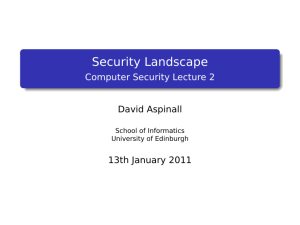
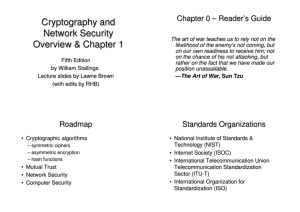

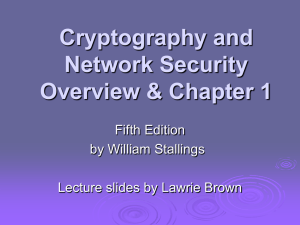
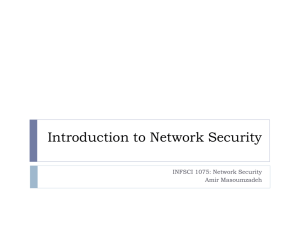

![Systems Assurance [Opens in New Window]](http://s3.studylib.net/store/data/007522633_2-e364c8f93e26286779d02c826b323ed6-300x300.png)
